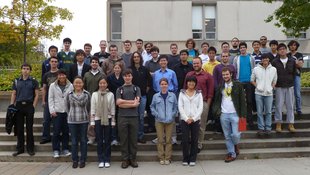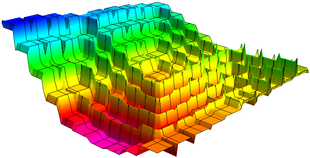10-327/Classnotes for Thursday November 4: Difference between revisions
From Drorbn
Jump to navigationJump to search
Johnfleming (talk | contribs) No edit summary |
No edit summary |
||
| (2 intermediate revisions by 2 users not shown) | |||
| Line 10: | Line 10: | ||
And once we found this delta(x_0) we should divide by 2 so that delta(x)>delta(x_0) for all x in X? Because it is not necessarily true that we can find a ball of radius delta(x_0) around x_0 to fit into ball?-Kai |
And once we found this delta(x_0) we should divide by 2 so that delta(x)>delta(x_0) for all x in X? Because it is not necessarily true that we can find a ball of radius delta(x_0) around x_0 to fit into ball?-Kai |
||
*I think you are correct, (if you follow the proof on the blackboard shots to the letter) as an example of what you are talking about take the open cover of [0,1] using sets of the form [0,x) for x<3/4 and (y,1] for y>1/4. Then <math>\Delta (x)\geq 1/4</math> and at 1/2 <math>\Delta (1/2)=1/4</math> but no ball of radius 1/4 around 1/2 fits inside any of the sets. So we will need to take a smaller value than <math>inf(\Delta (x))</math> as our value of <math>\delta_0</math> for Lebesgue's Lemma. Dividing by two as you suggest should work fine to fix this problem... Maybe it's just me, but in proof's like this I always feel the urge to divide the final answer by 2, just in case I mixed up some some strict inequality, with a non-strict one somewhere - [[Johnfleming|John]] |
*I think you are correct, (if you follow the proof on the blackboard shots to the letter) as an example of what you are talking about take the open cover of [0,1] using sets of the form [0,x) for x<3/4 and (y,1] for y>1/4. Then <math>\Delta (x)\geq 1/4</math> and at 1/2 <math>\Delta (1/2)=1/4</math> but no ball of radius 1/4 around 1/2 fits inside any of the sets. So we will need to take a smaller value than <math>inf(\Delta (x))</math> as our value of <math>\delta_0</math> for Lebesgue's Lemma. Dividing by two as you suggest should work fine to fix this problem... Maybe it's just me, but in proof's like this I always feel the urge to divide the final answer by 2, just in case I mixed up some some strict inequality, with a non-strict one somewhere - [[Johnfleming|John]] |
||
**Thanks John very nice example. Can you also help me with this question? "delta(x) isn't a radius that we can fit a ball inside one of the U's. It is the supremum of all possible radius. Wouldn't that give us a problem in showing delta(y)>=delta(x)-epsilon when d(x,y)<epsilon?"-Kai |
|||
***I don't think there is any problem with this step. |
|||
Without loss of generality <math> \epsilon < \Delta (x)</math> otherwise the condition holds vacuously. |
|||
Suppose we construct a ball of radius r such that <math> r > \epsilon </math> around x so that it is a subset of some U in the cover, then we can construct a ball of radius <math>r - \epsilon</math> around y such that this ball is also in U. So <math> \Delta (y) \geq r-\epsilon </math> for all r such that a ball of radius r exists around x as in the proof. Which implies <math> \Delta (y) \geq sup(r) - \epsilon </math> implies <math> \Delta (y) \geq \Delta (x) - \epsilon </math>. Hopefully this makes sense and works - [[Johnfleming|John]] |
|||
-Yes. Makes sense. Nice and concise thanks! -Kai |
|||
Latest revision as of 08:43, 19 December 2010
| ||||||||||||||||||||||||||||||||||||||||||||||||||||||||||||
See some blackboard shots at BBS/10_327-101104-142342.jpg.
| Dror's notes above / Student's notes below |
- Question: Regarding the proof of the Lebesque Number Lemma, let T(x) be the function we were working with in the proof. I am confused with how we reached the conclusion that if d(x,y)<E, then T(y)>= T(x) - E. I know that it was said that this is just an application of the triangle inequality, but I am having a bit of trouble seeing that. Hopefully someone can make this point a bit clearer for me. Thanks! Jason.
- If you could find a ball of radius 7 around which fits inside some set , and you move just a 1 unit away to , then by the triangle inequality the ball of radius 6 around is entirely contained inside the ball of radius 7 around so it is entirely contained in . Drorbn 18:37, 6 November 2010 (EDT)
- I have some doubts with Lebesgue number lemma too.. this delta(x) isn't a radius that we can fit a ball inside one of the U's. It is the supremum of all possible radius. Wouldn't that give us a problem? Don't we need to subtract some small positive value and then find a valid radius? I am not sure if there should be some technicality involved here.-Kai
- If you could find a ball of radius 7 around which fits inside some set , and you move just a 1 unit away to , then by the triangle inequality the ball of radius 6 around is entirely contained inside the ball of radius 7 around so it is entirely contained in . Drorbn 18:37, 6 November 2010 (EDT)
And once we found this delta(x_0) we should divide by 2 so that delta(x)>delta(x_0) for all x in X? Because it is not necessarily true that we can find a ball of radius delta(x_0) around x_0 to fit into ball?-Kai
- I think you are correct, (if you follow the proof on the blackboard shots to the letter) as an example of what you are talking about take the open cover of [0,1] using sets of the form [0,x) for x<3/4 and (y,1] for y>1/4. Then and at 1/2 but no ball of radius 1/4 around 1/2 fits inside any of the sets. So we will need to take a smaller value than as our value of for Lebesgue's Lemma. Dividing by two as you suggest should work fine to fix this problem... Maybe it's just me, but in proof's like this I always feel the urge to divide the final answer by 2, just in case I mixed up some some strict inequality, with a non-strict one somewhere - John
- Thanks John very nice example. Can you also help me with this question? "delta(x) isn't a radius that we can fit a ball inside one of the U's. It is the supremum of all possible radius. Wouldn't that give us a problem in showing delta(y)>=delta(x)-epsilon when d(x,y)<epsilon?"-Kai
- I don't think there is any problem with this step.
- Thanks John very nice example. Can you also help me with this question? "delta(x) isn't a radius that we can fit a ball inside one of the U's. It is the supremum of all possible radius. Wouldn't that give us a problem in showing delta(y)>=delta(x)-epsilon when d(x,y)<epsilon?"-Kai
Without loss of generality otherwise the condition holds vacuously. Suppose we construct a ball of radius r such that around x so that it is a subset of some U in the cover, then we can construct a ball of radius around y such that this ball is also in U. So for all r such that a ball of radius r exists around x as in the proof. Which implies implies . Hopefully this makes sense and works - John -Yes. Makes sense. Nice and concise thanks! -Kai

![{\displaystyle [0,1]}](https://wikimedia.org/api/rest_v1/media/math/render/svg/738f7d23bb2d9642bab520020873cccbef49768d)
















